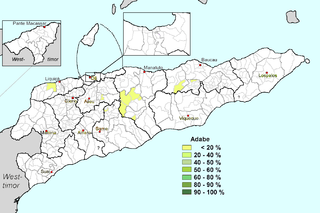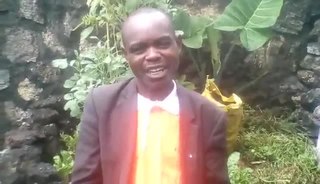Related Research Articles

Wetarese is an Austronesian language of Wetar, an island in the south Maluku, Indonesia, and of the nearby islands Liran and Atauro, the latter island separate from the mainland of East Timor, north of Dili.

Pashayi or Pashai is a group of Indo-Aryan languages spoken by the Pashai people in parts of Kapisa, Laghman, Nangarhar, Nuristan, Kunar and Kabul provinces in Northeastern Afghanistan.
The Sapo language, also known as Sarpo or Southern Krahn, is a Kru language of the Niger–Congo language family. It is spoken in eastern Liberia, primarily in Grand Gedeh County and Sinoe County, by the Sapo people. Its dialects include: Juarzon, Kabade (Karbardae), Nomopo (Nimpo), Putu, Sinkon (Senkon), and Waya (Wedjah).
The Gbi and Dorue language, also known as Gbee or Gbi and Dorue, is similar to the Krahn language of the Niger–Congo language family. It is spoken in northern Liberia which is a district within Nimba County. Its dialects include Gbi and Dorue. It has a lexical similarity of 78% with the Bassa language.
Gamo-Gofa-Dawro is an Omotic language of the Afroasiatic family spoken in the Dawro, Gamo Gofa and Wolayita Zones of the Southern Nations, Nationalities, and Peoples' Region in Ethiopia. Varieties are spoken by the Gamo, Gofa, Dawro; Blench (2006) and Ethnologue treat these as separate languages. Zala presumably belongs here as well. Dialects of Dawro (Kullo-Konta) are Konta and Kucha. In 1992, Alemayehu Abebe collected a word-list of 322 entries for all three related dialects.
Krumen is a dialect continuum spoken by the Krumen people of Liberia and Ivory Coast. It is a branch of the Grebo languages, a subfamily of the Kru languages and ultimately of the Niger–Congo languages. It had 48,300 speakers in 1993. The main varieties are:
Central Tibetan, also known as Dbus, Ü or Ü-Tsang, is the most widely spoken Tibetic language and the basis of Standard Tibetan.
Western Krahn is the principal language spoken by the Krahn people of Liberia and Ivory Coast. It is part of a series a dialects of the Wee (Guere) dialect continuum spoken by the Krahn and Guere peoples.
Pamona is an Austronesian language spoken in Central and South Sulawesi, Indonesia. It is part of the northern group of the Kaili–Pamona languages.

Lega is a Bantu language, or dialect cluster, of the Democratic Republic of the Congo. There are two major varieties, Shabunda Lega and Mwenga Lega; Mwenga Lega, with about 10% of speakers, finds Shabunda difficult to understand. Kanu has been assigned a separate ISO code but is a dialect of Shabunda, and no more divergent than other dialects.
Southern Luo is a dialect cluster of Uganda and neighboring countries. Although Southern Luo dialects are mutually intelligible, there are six ethnically and culturally distinct varieties which are considered to be separate languages socially.
Glaro and Twabo are two largely mutually intelligible dialects of the Wèè languages which are divergent other. Ethnologue reports that Twabo has slight intelligibility with some dialects of Eastern Krahn.
Faiwol is one of the Ok languages of Papua New Guinea. It is spoken at the headwaters of the Fly, Palmer, and Murray rivers in Western Province. There are numerous dialects, including Faiwol proper, Angkiyak, Wopkei, Setaman, Selbang, Dimtikin, and Kauwol on the Indonesian border.
Kayan is a dialect cluster spoken by the Kayan people of Borneo. It is a cluster of closely related dialects with limited mutual intelligibility, and is itself part of the Kayan-Murik group of Austronesian languages.
Jofotek-Bromnya is a Papuan language of Sarmi Regency, Papua, Indonesia.
Lamaholot, also known as Solor or Solorese, is a Central Malayo-Polynesian dialect cluster of Flores, Indonesia. The varieties may not be all mutually intelligible; Keraf (1978) reports that there are 18 languages under the name.
Shö is a Kuki-Chin language dialect cluster of Burma and Bangladesh. There are perhaps three distinct dialects, Asho (Khyang), Chinbon, and Shendu.

Itneg is a South-Central Cordilleran dialect continuum found in the island of Luzon, Philippines. This language and Ilocano are spoken by the Itneg people in Abra.
Haveke is a Kanak language of New Caledonia, in the commune of Voh. Bwatoo dialect is distinct.
Ziah Town was a small town in Grand Gedeh County in southeastern Liberia and serves as the administrative seat of Konobo District. Majority of the residents are ethnic Krahn and many use its language on a daily basis. it is a city now with about 3000 plus people living there from : konobo, Glio,Twabo putu and sometimes Glaro( the area used to be part of grand Gedeh county now River Gee)
References
- ↑ Konobo at Ethnologue (25th ed., 2022)

- ↑ Konobo language at Ethnologue (17th ed., 2013)
